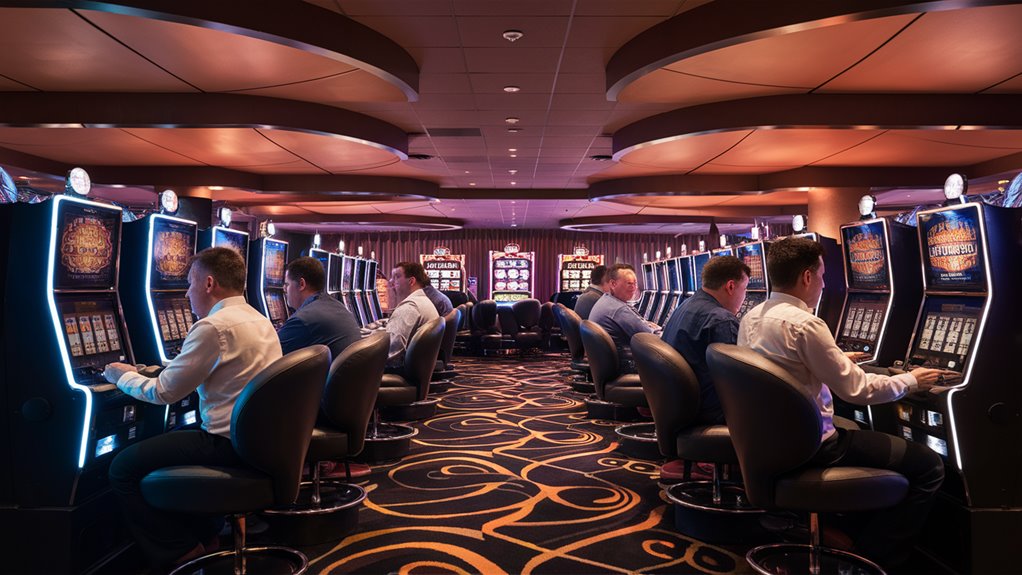Table of Contents
ToggleHow Gamblers Stay Hooked: Key Points

The Brain’s Reaction to Near-Wins and Rewards
Near-wins make our brains light up with lots of dopamine, almost like we really won. This strong brain reaction to close calls keeps us playing, even if we lose. Random reward times create strong habits, as prizes come at unexpected times.
The Look and Feel of Casinos Draw Players In
Casinos today are built smartly to keep players around. Main tricks include:
- No windows to make you lose track of time
- Lights that don’t change, so time seems still
- Sounds that focus on wins, not losses
- Layouts that make you walk by more games
Brain Activity During Gambling
Areas like the ventral striatum and nucleus accumbens are very active when we gamble, reacting to:
- The thrill of the unknown
- Things linked to gaming
- Foamblaze Slots
- Thinking about risks and rewards
- Finding out you won
Thinking and Behavior Connections
Several brain boosters work together to keep gambling habits strong:
- Feeling good in social places
- Viewing near-wins as almost good enough
- The hope for future rewards, pulling us deeper
- Random wins keeping hope alive for a big win
This mix of mind, place, and brain areas keeps players coming back.
Brain Responses to Near-Wins in Gambling: Role of Dopamine
The Impact of Almost Winning
Near-wins in betting have a big effect, pushing us to bet more, even when we lose. These experiences trick our brain circuits, making us feel like we’re getting ahead or improving.
When game symbols almost match or you miss a lucky number, your brain sends out dopamine, essential for desire and happiness.
How Our Brains Deceive Us
Seeing patterns and the gambler’s myth fool us into thinking we will win soon after many close tries. But really, each bet is independent.
Designed Near-Wins
Game creators purposely include near-misses in devices like slot machines. They show these near-hits more than just by chance would.
This intentional design taps into our brain mistakes and makes us play more with:
- Increase in hopes
- Tricking us into feeling skilled
- More emotional investment
- Better dopamine releases
- Extended play times
Breaking Free from the Mind Trap
Near-misses are big brain drivers but don’t actually get us closer to winning or improving. Recognizing this can help reduce gambling’s addictive pull.
The Mind Tricks and Design Tactics of Casinos

Slick Design in Modern Casinos
Casinos use clever design tricks to lure players and hold them longer.
The ambiance created by smart setups draws in guests.
Tweaking Your Senses and Movement
Design tactics include:
- Lights meant to keep the same vibe all day
- Sounds of winning and music
- Maze-like layouts for more exposure to games
- No windows to block outside time cues
Colors and Comfort
Design strategies involve:
- Bold colors and shiny objects
- Climate control for comfort
- Floor designs leading you to games
- Sound systems for an immersive atmosphere
Strategic Placement of Services
The clever placement of essential services creates a complete play loop:
- ATMs near busy areas
- Food and drink spots near games
- Bathrooms that make you walk past more games
- Show areas that keep you longer
This mix of design and brain tricks builds a cycle that draws players back and makes them stay.
Game Reward Schemes
Understanding Reward Patterns in Modern Gaming Systems
The Brainwork of Changing Rewards
New game areas use smart reward schemes that target our brain’s desire centers.
Shifting reward times are key, providing unpredictable rewards, keeping players engaged.
The Brain’s View on Near-Wins and Dopamine
Near-win moments in games release https://maxpixels.net/ a lot of dopamine, similar to real wins, although not actual wins.
The brain treats these near-wins as signs of possible rewards, aiding game engagement.
Game mechanisms set times for wins or near-wins every few rounds to maintain optimal player engagement.
Strategic Reward Timing
Stretching Out Prize Patterns
New gaming spots apply stretched reward timings, marked by frequent small wins that decrease as prize values increase.
This strategic approach mixes both quick joy moments and anticipation for bigger prizes.
The smart mix of random rewards, near-win instances, and planned win timings generates a strong pull on the mind, keeping players returning often.
Bringing It All Together
The combination of these prize strategies is crucial for intelligent game design, involving:
- Varying reward timings
- Dopamine boosts from near-wins
- Clever timing for rewards
- Increasing prize values
- Ensuring player return
